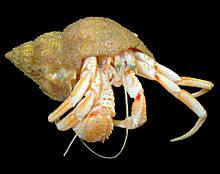Calliactis parasitica
| Calliactis parasitica | |
|---|---|

| |
| Scientific classification | |
| Domain: | Eukaryota |
| Kingdom: | Animalia |
| Phylum: | Cnidaria |
| Class: | Hexacorallia |
| Order: | Actiniaria |
| Family: | Hormathiidae |
| Genus: | Calliactis |
| Species: | C. parasitica
|
| Binomial name | |
| Calliactis parasitica (Couch, 1844)
| |
| Synonyms [1] | |
|
List
| |
Calliactis parasitica is a species of sea anemone associated with hermit crabs. It lives in the eastern Atlantic Ocean and Mediterranean Sea at depths between the intertidal zone and 60 m (200 ft). It is up to 10 cm × 8 cm (3.9 in × 3.1 in) in size, with up to 700 tentacles, and is very variable in colour. The relationship between C. parasitica and the hermit crab is mutualistic: the sea anemone protects the hermit crab with its stings, and benefits from the food thrown up by the hermit crab's movements.
Description
Calliactis parasitica is up to 100 millimetres (3.9 in) tall, and 80 mm (3.1 in) wide,[2][3] with the base of the column being slightly wider.[1] The surface of the column is rough and leathery with a grainy appearance, but has no tubercles and is not divided into sections.[1] It is variable in colouring,[1] but is usually cream or buff in colour, with blotches and streaks of reddish or greyish brown, which tend to form vertical stripes.[2]
The basal disc is concave, and able to stick firmly to the substrate.
Distribution
Calliactis parasitica is found in the north-eastern
Ecology

Although Calliactis parasitica will occasionally attach to stones or empty shells, it is typically found on a gastropod shell inhabited by a hermit crab, and several individuals may live on the same shell.[3] In the British Isles, the hermit crab is usually Pagurus bernhardus,[2] but other species may be associated with C. parasitica in other parts of its range.[1] C. parasitica is thought to use a chemical signal to detect its favoured shell, that of the whelk Buccinum undatum, because it has been observed in aquaria to mount the shell of a living B. undatum, although the whelk ensures that the sea anemone does not remain there.[3]

Calliactis parasitica can survive without the hermit crab, and the hermit crab can survive without C. parasitica, but they associate with each other to their mutual benefit; this is known as
Octopuses will avoid shells bearing C. parasitica, but will persist in attacking shells containing the hermit crab Pagurus prideaux and bearing the sea anemone Adamsia palliata.[4] In aquarium settings, the mutualism between C. parasitica and the hermit crab Dardanus arrosor can break down; this breakdown is prevented or reversed when chemical signals from octopuses are present. The presence of cephalopods may therefore be necessary for the relationship between the hermit crab and the anemone to be maintained.[5]
Taxonomy
Calliactis parasitica was
Toxin
Calitoxin (CLX), derives its name from the sea anemone Calliactis parasitica.[8]
References
- ^ a b c d e f g h i M. J. de Kluijver & S. S. Ingalsuo. "Calliactis parasitica". Macrobenthos of the North Sea: Anthozoa. Universiteit van Amsterdam. Archived from the original on July 24, 2011. Retrieved February 21, 2011.
- ^ ISBN 978-0-19-854055-7.
- ^ ISBN 978-0-521-72059-5.
- ISBN 978-0-521-64583-6.
- ISBN 978-0-632-06048-1.
- ^ a b Richard Quiller Couch (1844). Part III, containing zoophytes and calcareous corallines. Cornish Fauna, being a compendium of the natural history of the county. Truro: L. E. Gillet.
- .
- ^ Cariello, L; de Santis, A (1989). “Calitoxin, a neurotoxic peptide from the sea anemone Calliactis parasitica: amino acid sequence and electrophysiological properties”. Biochemistry 28 (6): 2484-9
External links
- Calliactis parasitica[permanent dead link], Hexacorallians of the World
- Photos of Calliactis parasitica on Sealife Collection
